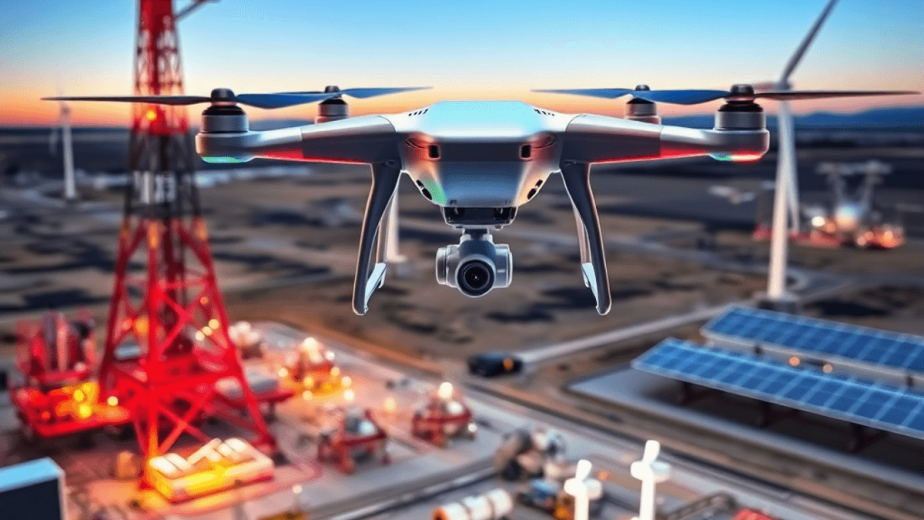Introduction
Drone technology has rapidly transformed utility inspections, offering innovative solutions for monitoring infrastructure. The growing adoption of drone inspections in the industry is a testament to their efficiency and effectiveness. These unmanned aerial vehicles provide significant advantages when it comes to assessing distribution power poles.
In this article, we will explore the top benefits of inspecting distribution power poles with drones:
- Improved Safety: Reducing personnel exposure to hazardous conditions
- Cost-Effectiveness: Achieving labor cost reductions and time savings
- Enhanced Data Collection: Capturing detailed visual data for accurate assessments
- Access to Hard-to-Reach Areas: Navigating challenging environments effortlessly
- Efficiency in Inspections: Speeding up inspection processes significantly
- Real-Time Data Transmission: Facilitating immediate analysis for timely decisions
- Automated Processes: Streamlining workflows through advanced technology
- Environmental Monitoring and Compliance Support: Ensuring adherence to safety standards
Embracing drone technology is key to revolutionizing infrastructure management.
1. Improved Safety
The safety benefits of drone inspections are significant. Traditional methods of inspecting distribution power poles often require personnel to work in hazardous environments, exposing them to risks including electrical hazards, falls, and adverse weather conditions. Drones mitigate these dangers by allowing inspections to be conducted remotely, reducing the need for workers to climb poles or access dangerous locations.
Key advantages include:
- Hazard Reduction: Drones can navigate challenging terrains and inspect high structures without putting human lives at risk.
- Accident Prevention: With reduced personnel exposure to dangerous situations, the likelihood of accidents decreases dramatically.
Several case studies illustrate the improved safety outcomes achieved through drone technology:
- A utility company in California adopted drone inspections for their distribution network. They reported a 60% reduction in on-site personnel during inspections, leading to zero accidents in subsequent operations.
- In Florida, drones were employed after a hurricane. Inspectors utilized drones to assess damage and identify hazards without risking their safety during the immediate aftermath of the storm.
These examples emphasize how drone technology enhances safety while maintaining the integrity and reliability of infrastructure inspections.
2. Cost-Effectiveness
The integration of drone technology in pole inspections leads to significant cost savings for utility companies. The potential for labor reductions can range from 30% to 50%, as drones minimize the need for extensive crews and equipment traditionally required for inspections. This not only reduces direct labor costs but also enhances the allocation of workforce to other critical tasks.
Key Factors Contributing to Cost-Effectiveness:
- Faster Inspection Processes: Drones can cover large areas quickly, allowing for more frequent inspections without compromising quality. Traditional methods often involve time-consuming setups and manual assessments.
- Reduced Equipment Costs: Utilizing drones lessens the reliance on heavy machinery such as bucket trucks, which are costly to operate and maintain.
- Decreased Downtime: Quick inspections mean less disruption to normal utility operations. This efficiency translates into reduced downtime, ensuring uninterrupted service delivery.
Adopting drone technology leads to a streamlined inspection process that is not only more efficient but also results in substantial savings. These factors collectively enhance the overall cost-effectiveness of integrating drone solutions into utility management strategies.
3. Enhanced Data Collection
Drones are changing the game when it comes to data accuracy in inspections, especially for distribution power poles. These advanced devices have features that allow them to capture detailed images and thermal scans, giving utility companies the visual information they need for thorough evaluations.
Key Features:
- High-Resolution Imaging: Drones equipped with high-quality cameras can produce images that reveal minute details often missed during traditional inspections. This level of detail is crucial for identifying wear, corrosion, or structural issues on power poles.
- Thermal Imaging: Drones can also utilize thermal cameras to detect anomalies such as overheating components or electrical faults. This technology enables proactive maintenance planning by identifying potential problems before they escalate into serious failures.
The accurate assessments made possible through these technologies help utility companies plan their maintenance activities more effectively. By prioritizing repairs based on the severity of issues detected, they can allocate resources efficiently and minimize service disruptions. This proactive approach leads to less downtime and improves the overall reliability of power distribution systems.
In addition, the use of advanced data collection methods not only enhances the quality of inspections but also supports better decision-making processes in utility management strategies.
4. Access to Hard-to-Reach Areas
Drones are great at getting into difficult places that often make it hard for human inspectors to do their job. They are light and can move around easily, which allows them to go to areas where traditional inspection methods have a hard time.
Key Benefits
Here are some of the main benefits of using drones for inspecting hard-to-reach areas:
- Remote Location Accessibility: Drones can easily reach remote or isolated distribution power poles, ensuring comprehensive coverage. This capability is crucial for inspections in mountainous, forested, or disaster-affected regions.
- Safety in Dangerous Environments: Inspecting power poles in hazardous locations, such as near steep cliffs or unstable ground, poses risks to personnel. Drones eliminate the need for human presence in these areas, drastically improving safety outcomes.
- Time Efficiency: By utilizing drones for hard-to-reach inspections, utility companies can save time spent on planning and executing complex ground-based operations.
- Detailed Inspections of Challenging Structures: Drones equipped with high-resolution cameras and sensors can provide detailed views of structures that may be difficult to assess from the ground level.
These advantages highlight how drone technology enhances the inspection process for distribution power poles, making it a valuable asset for utility companies seeking to maintain infrastructure integrity while ensuring safety and efficiency.
5. Efficiency in Inspections
Drone technology significantly enhances inspection speed, leading to impressive operational efficiency for utility companies. Traditional inspection methods often involve time-consuming processes, including manual climbing, equipment setup, and lengthy assessments. Drones streamline these tasks, enabling rapid inspections with minimal human intervention.
Key benefits include:
- Rapid Deployment: Drones can be quickly launched and operated, reducing the time between inspections.
- Coverage Area: A drone can cover large areas in a fraction of the time it takes for ground crews to inspect the same locations.
- Data Collection: High-resolution imaging and thermal scans are captured simultaneously during flight, eliminating the need for multiple visits.
This increased efficiency directly impacts scheduling and resource allocation. Utility companies can:
- Optimize workforce management by reallocating personnel to other critical tasks.
- Reduce downtime associated with inspections, allowing for faster maintenance and repairs.
- Schedule more frequent inspections without incurring additional costs.
As drone technology continues to evolve, the potential for enhanced operational efficiency becomes even more promising. Embracing these advancements positions utility companies to improve their service delivery while maintaining safety and compliance standards.
6. Real-Time Data Transmission
Real-time data transmission capabilities significantly enhance the value of drone inspections for distribution power pole monitoring. Drones equipped with advanced sensors and communication technologies provide a live data feed during drone inspections. This immediate access to crucial information allows utility operators to monitor the condition of infrastructure as it is being inspected, ensuring that any anomalies can be detected without delay.
Key benefits include:
-
Immediate Analysis: The capability for instant processing of data enables rapid identification of potential issues, such as structural weaknesses or equipment malfunctions. This proactive approach mitigates risks and prevents minor concerns from escalating into major problems.
-
Timely Decision-Making: Armed with real-time insights, utility operators can make informed decisions on maintenance needs, resource allocation, and emergency responses. This responsiveness contributes to greater reliability in service delivery.
Incorporating live data feed capabilities into inspection workflows not only streamlines processes but also enhances the overall effectiveness of utility management strategies. By utilizing these advanced technologies, companies can ensure that their distribution networks remain safe and efficient while minimizing downtime and operational costs.
7. Automated Processes and 3D Modeling Capabilities
Automation in drone inspections represents a transformative shift in how utility companies manage their assets. Drones equipped with advanced technology streamline the inspection process, reducing the need for manual intervention. This automation not only minimizes labor costs but also enhances accuracy by eliminating human error.
Key benefits of automation in grid inspection include:
- Consistency: Automated flights ensure uniform coverage during inspections, capturing data from every angle without missing critical details.
- Scalability: As demand for inspections increases, automated drone operations can easily scale to meet these needs without significant resource allocation.
3D modeling for infrastructure management further elevates the capabilities of drone inspections. Drones can create detailed 3D models from captured data, offering a comprehensive view of distribution power poles and surrounding infrastructure.
The advantages of 3D modeling include:
- Enhanced Visualization: Stakeholders can visualize current conditions in a three-dimensional format, making it easier to identify potential issues.
- Informed Decision-Making: Utility operators can leverage accurate models for strategic planning, maintenance scheduling, and risk assessment.
Such advancements in automation and modeling are pivotal for improving operational efficiency and management strategies within the energy sector.
8. Environmental Monitoring and Regulatory Compliance Support with Drones
Drones are essential for environmental monitoring, particularly when it comes to evaluating the ecological impacts on power lines. Their ability to conduct thorough inspections enables utility companies to proactively tackle potential problems like:
- Vegetation Encroachment: Drones can navigate and capture images of areas where vegetation threatens the integrity of power lines. This capability enables timely interventions, preventing outages or damage caused by falling branches.
- Wildlife Monitoring: Drone technology facilitates tracking animal habitats near infrastructure, ensuring compliance with environmental regulations designed to protect local ecosystems.
The use of drones greatly helps utility companies follow safety regulations and meet compliance standards. Here are some key benefits:
- Accurate Condition Records: Regular drone inspections create reliable historical data, essential for audits and compliance checks.
- Real-Time Reporting: Immediate access to inspection results aids in rapid decision-making, aligning operations with regulatory requirements.
With these abilities, drones empower utilities to uphold high safety standards while effectively managing their environmental responsibilities. The integration of drone technology into ecological assessments not only enhances operational efficiency but also shows a dedication to sustainability.
Conclusion: The Future is Bright for Drone Technology in Utilities Management!
Embracing drone technology will revolutionize infrastructure management in the energy sector. The top benefits of inspecting distribution power poles with drones are clear: improved safety, cost-effectiveness, enhanced data collection, and more.
Consider these future trends:
- Integration of AI: Enhanced analytics will offer deeper insights into asset health.
- Advanced UAV Systems: Continuous improvements in drone capabilities will facilitate complex inspections.
- Sustainability Focus: Drones contribute to environmentally conscious practices by minimizing human exposure to hazardous conditions.
Staying informed about these advancements is essential. Engage with emerging technologies to optimize utility operations further. Explore innovations from companies like Mira Spatial, which are at the forefront of this transformation. Embrace the potential for a more efficient and sustainable future in utility management.


